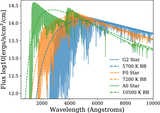The Influence of Host Star Spectral Type on Ultra-hot Jupiter Atmospheres
Abstract
Ultra-hot Jupiters are the most highly irradiated gas giant planets, with equilibrium temperatures from 2000 to over 4000 K. Ultra-hot Jupiters are amenable to characterization due to their high temperatures, inflated radii, and short periods, but their atmospheres are atypical for planets in that the photosphere possesses large concentrations of atoms and ions relative to molecules. Here we evaluate how the atmospheres of these planets respond to irradiation by stars of different spectral type. We find that ultra-hot Jupiters exhibit temperature inversions that are sensitive to the spectral type of the host star. The slope and temperature range across the inversion both increase as the host star effective temperature increases due to enhanced absorption at short wavelengths and low pressures. The steep temperature inversions in ultra-hot Jupiters around hot stars result in increased thermal dissociation and ionization compared to similar planets around cooler stars. The resulting increase in H- opacity leads to a transit spectrum that has muted absorption features. The emission spectrum, however, exhibits a large contrast in brightness temperature, a signature that will be detectable with both secondary eclipse observations and high-dispersion spectroscopy. We also find that the departures from local thermodynamic equilibrium in the stellar atmosphere can affect the degree of heating caused by atomic metals in the planet’s upper atmosphere. Additionally, we further quantify the significance of heating by different opacity sources in ultra-hot Jupiter atmospheres.
- Publication:
-
The Astrophysical Journal
- Pub Date:
- May 2019
- DOI:
- 10.3847/1538-4357/ab1485
- arXiv:
- arXiv:1903.12183
- Bibcode:
- 2019ApJ...876...69L
- Keywords:
-
- methods: numerical;
- planets and satellites: atmospheres;
- planets and satellites: gaseous planets;
- Astrophysics - Earth and Planetary Astrophysics;
- Astrophysics - Solar and Stellar Astrophysics
- E-Print:
- 13 pages, 9 figures, 2 tables. Accepted for publication in ApJ
